
Celebrating the Wildness
of Honeybees
The Natural Beekeeping Trust International Photographic Competition 2017
Photo Credit: Matt Somerville
Entry Dates: February 20th - September 1st 2017
The Natural Beekeeping Trust's unique photographic competition is a call to celebrate the honeybees' innate wildness. We encourage you to keep your eyes wide open to discover the places where honeybees live in freedom, in places of their own choosing - in rocks, chimneys, churches, trees and other secret places. Your photos will contribute to our mission to support the Bee in its essential wildness.
This Competition is free to enter for anyone. Children require an adult to enter on their behalf.
Up to four entries can be made - either individual pictures or a sequence of pictures telling a story, eg. following a bee and finding a hive or saving a tree colony
Competition Results
The aim of the competition was to celebrate the wildness of bees and draw attention to wild colonies that exist without any human interference. Although we knew the subject would be difficult to photograph, we received over 150 superb pictures from all around the world.
The diversity of nest sites ranged from statues, port bollards, telephone junction boxes, the ruins of Ankor Wat, snow covered logs, caves, cliffs, ancient human settlements and of course trees ... lots of trees. The stories that came with the pictures described colonies of over 10 years in age, and even a cave which has hosted bee colonies for over 100 years.
First Place - Guardian of the Oak - South Africa By Jenny Cullinan of Ujubee

A familiar scene to many beekeepers: the guard bee raising her front legs as bees arrive back, and the rapid negotiations following each arrival. Captured beautifully in this great photo showing a glimpse of unfettered bee life in the hollow of an old oak tree.
Joint Second Place - A 10 year old wild colony in a hollow plane tree - France.
By Emmanuel Faure

A rare glimpse inside a natural nest. The red propolised interior looks almost like an animal carcass. It reminds us that part of the superorganism is the propolis and hive shell, acting like a protective skin. Bees invest heavily in the production of propolis, it is a key component of hive health.
Joint Second Place - Nora's First Bee Hunt - USA
By Robin Radcliffe




The competition allowed entrants to submit a sequence of pictures to tell a story. These beautiful pictures of Nora's first bee hunt using a bee lining box speak for themselves.
I would like to thank the judges, Professor Thomas D Seeley of Cornell University and Heidi Herrmann of the Natural Beekeeping Trust for their help in the difficult task of selecting the final three pictures.
Jonathan Powell: Natural Beekeeping Trust and competition judge.
Competition Gallery
 Guardians of the Oak - South Africa- Ujubee |  #1 Buzz on the line? - UK - John Fowler (for those outside the UK this is a British telecom access cover) |  #2 Been there a while! - UK - John Fowler |
|---|---|---|
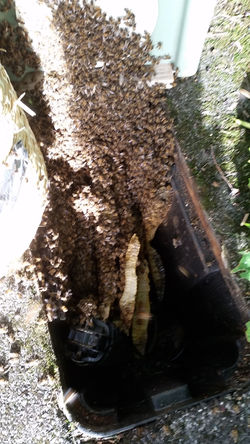 #3 That would be the reason for the buzzing. Successfully cut-out. - UK - John Fowler |  France - Adam Wright |  Northern Ireland - Sara Tutkington |
 When the bee looks straight at the camera - Northern Ireland - Sara Tutkington |  #3 Bees photographed at Mid Ulster Bee Apiary - Northern Ireland - Sara Tutkington | 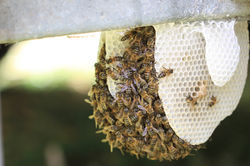 Under the horse box - South Africa - Ujubee |
 Log hive & Hens in Dublin - Ireland - Charlie Le Brun |  Pollen baskets- the honey bee’s version of sustainable grocery bags. - USA - Jenny Van Zanten Good point, and I might add they get greener the more they produce! |  Time of abundance in a BEEtree nest - South Africa - Ujubee |
 Honeybee on the Balsam - UK - Samuel Ward |  Propolis wall maintenence of a BEEtree nest |  Capensis bees in the oldest planted tree in South Africa, planted by Jan van Riebeeck in the 1660's - South Africa - Ujubee |
 Irish Black bees - Ireland - Charlie Le Brun |  The Photogenic Bee -USA - Rebekah Jackson |  The mulberry bees - South Africa - Ujubee |
 The Poplar Bees - South Africa - Ujubee |  The nest in the hollow oak - South Africa - Ujubee |  Through the peephole - South Africa - Ujubee |
 #1 Nora's Bee Hunt. First Bee - USA - Robin Radcliffe |  #2Nora's Bee Hunt. Bee Box - USA - Robin Radcliffe |  #3 Nora's Bee Hunt. Bee Hunt - USA - Robin Radcliffe |
 #4 Nora's Bee Hunt. Nora's Tree - USA - Robin Radcliffe |  #1 This ficus tree growing on the cliff face is a bee tree of sorts. Wild bees fly through the upper branches to reach their nest in the naturally occurring rock cavity. Hunter-gatherers have foraged (not farmed) honey at this site for many, many years, if not millennia. - South Africa - Neil Rusch |  #2 Twenty yards to the right of the base of the tree these figures are painted in red ochre. Thirty yards further to the right again there is a cave, which has been frequented by Homo sapiens for 77 000 years, at least, according the archaeological evidence and modern dating methods. - South Africa - Neil Rusch |
 #3 A substantial propolis wall (a feature of wild Cape honeybees, Apis mellifera capensis) and these guards protect the entrance to the wild nest, which can be/was accessed either by climbing up the tree or by traversing the rocky ledge to the right of the cavity. South Africa - Neil Rusch |  Lauri Miller - USA |  Lauri Miller - USA |
 Lauri Miller - USA |  Bringing in pollen. Feral bees in a tree. Creuse, France. by Paul Spierings - Netherlands |  Canada- Jessica Renaud |
 Going out for foraging. Feral bees in a tree. Creuse, France - by Paul Spierings - Netherlands |  Canada - Jessica Renaud |  Feral Bees in a tree taken at Creuse, France by Paul Spierings of the Netherlands |
 'Honey, I'm home!' Feral bees in a tree. Creuse, France. - By Paul Spierings - Netherlands |  #3 beauty and the bees - Canada - Martin Morissette |  #4 bee taking a pause from a long haule! - Canada - Martin Morissette |
 I took this photo of a Honeybee on a flower at Kew Gardens. I love the colours in this photograph and hoped to show the beauty of the bee. - UK - Roxanne Levy | 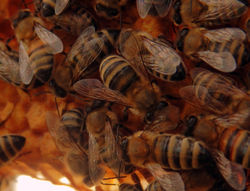 Busy as a Bee. The ladies working hard on comb in a cavity. - UK - Dawn Rigby |  Photo taken at Angkor Wat 2010. Black and white in the centre vertically and slightly to the right a single comb of wild Asian bees. You can zoom it a bit - Thailand - Craig Sanderson of Australia |
 This was just the outside of this hive, it continued shoulder deep into a hollow branch. These girls were about 40 feet up an old oak tree in a residential neighborhood. - USA - Leon Linkey |  #1 Bulgaria - Antony Croft |  #2 Bulgaria - Antony Croft |
 #1 Honey bee on Verbena UK - Kay Llewellyn |  #2 Honey bee on Verbena UK - Kay Llewellyn |  Blackberry Bloom - USA -Brian Brockman |
 Swarm! - UK - Simon Kelland |  Colony on the move - UK - Simon Kellam |  A swarm visits the garden - France - Bil Harley |
 Apis - Brazil - Marcio Lopes |  Apis 2 - Brazil - Marcio Lopes |  A free colony of mallorcan honey bees - Spain - Francesca Rosselló Bonet |
 Free and Happy Drone from a free colony in our Sanctuary in Mallorca Spain - Francesca Rosselló Bonet |  - Columbia - Alejandro Hinojosa |  Swarm arrival day checking the entrance out - UK -Keith Long |
 Established wild bees in a ash tree with exposed comb. - UK - Keith Long |  Arrival day for the swarm - UK - Keith Long |  The swarm arriving - UK- Keith Long |
 #2 Bees entering statue of Christ. - France - Thomas Gfeller |  # 1 Statue of Christ fill with bees. Propolis from the hive bleeds down the leg. - France - Thomas Gfeller |  Another picture of Honey bees in a Bollard at Chatham - UK - Dick Houghton |
 Honey bee colony in a bollard at Chatham Dockyard - UK - Dick Houghton |  Dry comb attached to the wall of rock shelter. These Cape honeybees, Apis Mellifera Capensis, remain in residence and active in the southern hemisphere autumn but have withdrawn deeper into the naturally occurring cavity in the rock face. - South Africa - Neil Rusch |  Amnesty for dandelion :) - Serbia - Gabriela Salai |
 #1 Wilderness behind the straw ring - Canada - Martin Morissette |  #2 Winter bee cluster in a wild hive - Canada - Martin Morissette |  - UK- Rachel Louise White |
 swarm of bees in Elder - Belgium - Katelijne De Herdt |  Wild colony in a monument , Shelter in a willow , Look - Bulgaria. Dimitar Dimitrov |  Our Bees during the breakfast.- Greece - Geraldine Thodos |
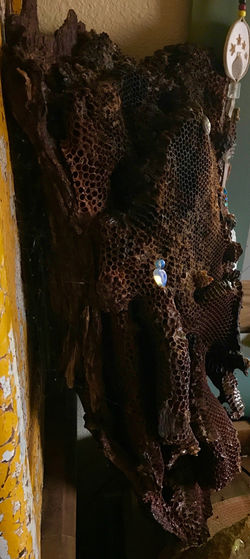 I got a rescue call about a tree down in a storm filled with bees. In the high winds and rain, the bees had perished, but this beautiful chunk of their inner world remained. - USA - Susan Knilans | 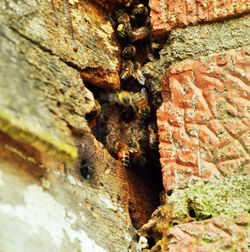 these bee's have been living in this house for over 20 years - USA - Roger Yeager | 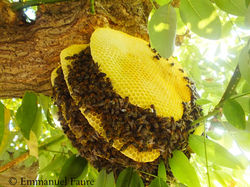 A small colony of Apis Mellifera Mellifera attached to an acacia branch. Marignane, southern France. - Emmanuel Faure |
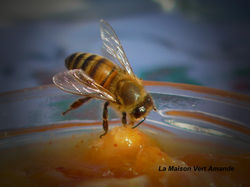 Our bee eat our marmalade during the breakfast - Greece - Geraldine Thodos |  open air hive in the woods. - USA Roger Yeager |  Our bee during the breakfast. Greece - Geraldine Thodos |
 Our bee at Kea island (Greece Cyclades) Geraldine Thodos |  Natural beehive - Australia - Tam Schwerdt |  Bee flying in nest entrance with goldenrod (Solidago sp.) pollen 9 Oct 2016 - Thomas Seeley (Judge - not eligible for prize, but thanks for sharing) |
 A feral colony established between two wooden walls. Bouc Bel Air, southern France, 2016. - Emmanuel Faure |  Wonderfully high bee tree nest in a sugar maple tree, outside Ithaca, NY. Arrow points to nest entrance. - Thomas Seeley (Judge, so entry not eligible for prize. Just for sharing :) |  A feral colony in a hollow plane tree. Active since more than 10 years. Southern France - Emmanuel Faure |
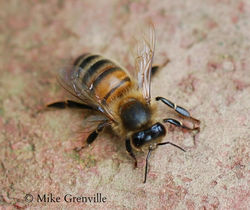 Bee Resting - UK - Mike Grenville |  A friend called - this was found under a single wide trailer on their property in the country.. many barns and buildings to choose from and this is where they called home. - USA- Debbie Horne |  The Queen - Italy - Edoardo Forno |
 A feral colony attached its combs to a bush. Seen in Riboux, southern France, winter 2016. - Emmanuel Faure |  Entrance of a bee colony established in a hollow plane tree. Seen in Robion, southern France, summer 2015. - Emmanuel Faure |  Wild swarm in a cherry tree, Burgundy, France, 2013 - Matthieu Guichard |
 Waiting for spring... Wild swarm in lime tree, 3.5 meters from the ground. Picture taken in march 2013, Thiverval-Grignon, France. Matthieu Guichard |  Bee colony in Chestnut tree on Dartmoor Feb 17. Fungal growth present at entrance - UK - Matt Somerville (Trustee - not eligible for prize.) |  Drinking Bee - Spain -Salvador Sanchez-Alonso |
 Close up of bees on Comb. Some of the wet fungal "gloop" has been removed - UK - Matt Somerville NBKT Trustee so not eligible for prize :-( |  #honeybee on Crepe Myrtle bush #honeybee on Golden Panda Bush # honeybee - Australia - Linda Hansbauer |  Another picture showing bees after a dry path was made.- UK - Matt Somerville NBKT Trustee so not eligible for prize :-( |
 This is a snapshot of a sweet bee-ing living free and wild in one of my hives - UK - Heidi Herrmann. Trustee submitting a picture for fun, but not eligible for a prize |  Inside the organic River and Roots Community Garden, Riverhead, New York - Jenny Intravia |
Competition Judges

Prof. Thomas D. Seeley

Jonathan Powell - Natural Beekeeping Trustee and Tree Beekeeper

Trustee Natural Beekeeping Trust
Prof. Thomas D Seeley
Thomas Seeley’s scientific research into the behaviour and social life of honeybees has given the world of beekeeping invaluable impulses for better sustainable practice. Through his groundbreaking work documented in Honeybee Democracy and Following the Wild Bees our understanding of bee behaviour and biology has been greatly enriched. Consequently Thomas Seeley has become the “patron saint” of beekeepers looking for bee-centered and sustainable approaches. His passion and reverence for the honeybee
is an enduring source of inspiration for anyone interested in the life of bees.
In recognition of his scientific work, he has received the Alexander von Humboldt Distinguished U.S. Scientist Prize; he been awarded a Guggenheim Fellowship, received a Gold Medal Book Award from Apimondia for The Wisdom of the Hive, and been elected a Fellow of both the Animal Behaviour Society and the American Academy of Arts and Sciences. In his own words, his most enduring honour is to have had a species of bee named after him: Neocorynurella seeleyi.
Jonathan Powell
Jonathan is a trustee of the Natural Beekeeping Trust as well as a founding member of Tree Beekeeping International, an organisation dedicated to furthering the craft of tree beekeeping.
Jonathan first started beekeeping as a child in the 70's, taught by his grandfather who kept bees for 60 years. In his beekeeping practice he is looking to learn from wild bees so as to let their preferences inform his beekeeping. To this end he was trained in the traditional methods of the Polish and Bakshir (Urals) tree beekeepers . He founded a peer group of natural beekeepers in Somerset,UK, writes at beeswing.net and gives talks and training on Bee Centered Beekeeping and Tree Beekeeping.
He is the author of the first ever guide to Tree Beekeeping, and his work has recently been featured here
Heidi Herrmann
For those familiar with the work of the Natural Beekeeping Trust, Heidi needs no introduction. She is a founder trustee and a major contributor both to this website and the Trust's Facebook page. She is a passionate and outspoken advocate of bee-centred beekeeping. Her advocacy is based on experience, having kept many hives of bees naturally and treatment-free for longer than she is prepared to admit. She's pretty keen on horses and sheep too.

